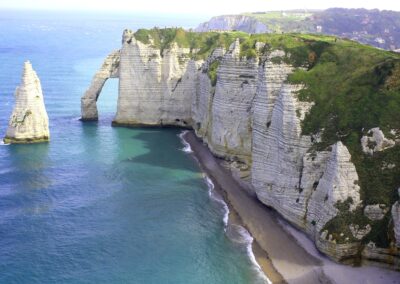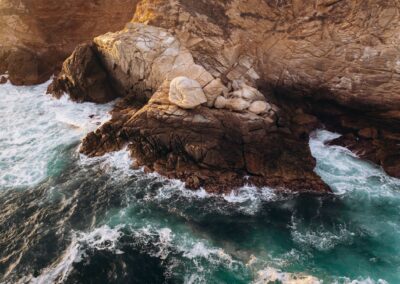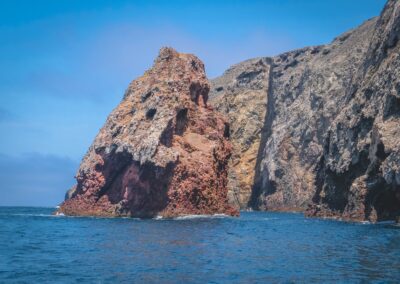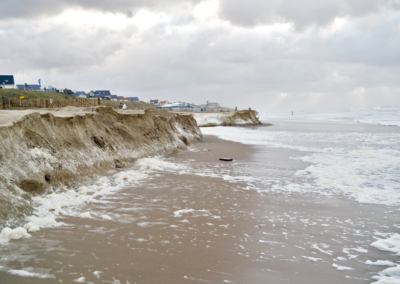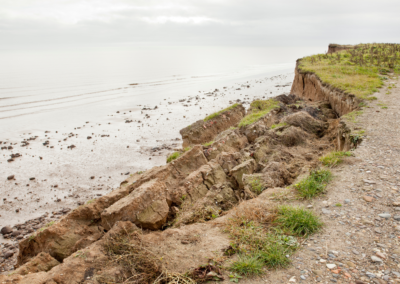
COASTAL EROSION
What is coastal erosion?
The Mission for Natural Heritage releases an awareness campaign aiming to share knowledge about the causes and effects of coastal erosion, as well as solutions proposed or already put in place, engaging citizens from shore to shore all along the Mediterranean basin.

What happens to our coastline?
Have you noticed how beaches get smaller and cliffs collapse?
Places you used to visit are not recognizable anymore while, in some cases, entire neighbourhoods literally fall into the sea.
This is the impact of coastal erosion, let’s learn more about it!
The sand you put your towel on is only a tiny part of the actual beach. Beaches are geological systems made up of many different parts (see figure below).
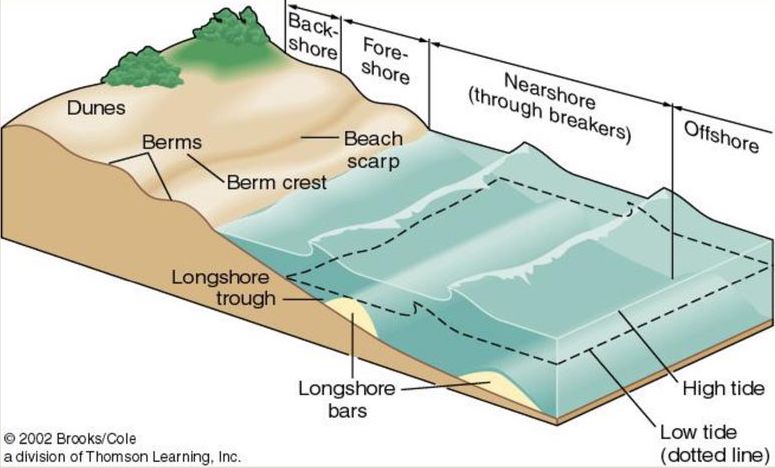
Dunes are mounds of sand formed by the wind, usually along the beach while berms are landward-sloping shelves of sand on the backshore of a beach. A beach scarp is an almost vertical slope that fronts a berm on a beach. Longshore troughs are long, wide, shallow depressions of the sea floor parallel to the shore. On the other hand, longshore bars are linear ridges of sand whose long axis is parallel to the shore.

What causes it?
The different parts of coastal areas are constantly on the move, creating a natural dynamic of accretion and erosion that shapes the coastline over time. There is a constant flow of sand from the land into the ocean.
On the other hand, climate change is transforming these dynamics due to sea level rise, changes in the wind and waves, droughts, storms and floods.
Society established many activities on the coastline and the land inwards, affecting these natural dynamics: promenades, harbours, groynes, dams and barriers change the natural drift that shapes the shores of the region.
Sediment budget is also affected by changes in the flows of rivers and streams that transport the sand from the continent into the sea, as well as activities like sand mining.

How can we identify erosion?
Researchers follow up the erosion processes by taking pictures of the beaches over time and thus be able to compare and monitor the shores’ dynamics. For example, Coastsnap allows scientists to receive input data for their analysis. The Mission for Nature awareness raising campaign aims to identify erosion hotspots, where the natural dynamic of sediments has already progressed so much you can perfectly observe a clear impact on the shores.
Rocky shorelines
Rocky shorelines are coastal zones where the rock is predominant. Weaker rocks (e.g. clays) have less structural strength and are easily affected by erosion, while harder types of cliff (e.g., limestone and chalk) are more resistant.
There are different stages of rocky coastline erosion starting from a crack on the rock that can become a cave or an arch that can evolve to the complete separation of a part of the rock forming a stack. The erosion phenomena can reduce the stack down to a stump. The different stages can be shown in the figure below.

Sandy beaches
On sandy beaches the phenomenon is not so easy to be identified! The erosion signs include sand loss, a reduction of the beach width and of the dunes size. In eroded beaches a lowered beach slope is observed while there is absence of nearshore bars, berms and or scarps.

How does it affect us?
But how can these changes affect our everyday life and leisure activities? Coastal erosion can lead to coastal property loss, including damage to infrastructures and loss of land. In addition, landmarks of high touristic or cultural value may be destroyed.

What can we do?
Recovery of the needed sediment dynamics for preserving our shores is a complex issue, but many good examples are available!
There are various techniques to slow down or even stop the coastal erosion phenomena in a coastal area. The different methods can be classified in two big categories, soft and hard engineering methods.
The soft engineering methods are less intrusive and include beach nourishment, dunes regeneration, beach scraping, cliff stabilization, etc. These methods use natural materials, such as sand and local vegetation to protect the coastal zone.
On the other hand, hard engineering methods are more expensive solutions that include man-made (artificial) infrastructure, mainly aiming to reduce the power of waves. These include, among others, sea walls, revetments, groynes, breakwaters, wave attenuators, cliff-fixing with metal structures.
The best solutions are those able to recover the natural sediment dynamics and create long term resilience to this phenomena. How we plan urban areas, how we manage rivers, how we design harbours and many other factors are key to understanding the specificities challenge for each area and develop transformative and long term solutions. Erosion is a complex system which can not be managed only through engineering, as it needs to be tackled with a holistic approach, considering socioeconomic factors and biophysical factors. The Integrated Coastal Zone Management (ICZM) approach was developed to balance environmental, economic, social, cultural and recreational objectives, all within the limits set by the common goal to protect and restore natural dynamics.
COASTAL EROSION AROUND THE MED
Videos
Explore testimonies of stakeholders and experts around the Mediterranean area and learn more on coastal erosion challenge.
Professor Eulàlia Sanjaume from the University of Valencia is explaining what triggers coastal erosion in Valencia costal area and what measures have been tested so far.
Coastal erosion affects Mediterranean endangered species, as the Monk seal: Monachus monachus! MoM, The Hellenic Society for the Study and Protection of the Monk seal, explains how in a short video.
In this video, the OPERAs Project proposes one nature based solution fighting coastal erosion, i.e., the construction of semi-stabilized dunes around heavily used metropolitan beaches.
Listen to Evis Çano, Environmental Specialist AKBN, to have a better understanding of the coastal erosion problem in Albania!
In this short educational video, Dr. Constantine Michailides, Assistant Professor in Marine-Hydraulic Works at International Hellenic University (Civil Engineering Department), explains the importance of monitoring coastal erosion technologies for acquiring data which are necessary to develop policies and coastal planning actions.
With one of the most energetic coastlines in the world, Portugal is one of the countries most affected by erosion processes on its coast.
The problem of coastal erosion is particularly acute in Cyprus as well as in other Mediterranean countries, with a potential increase in the phenomenon due to climate change and human activities.
Mr. Théophile Bongarts explains what are the challenges for coastal cities due to sea level rise and its impacts, including coastal erosion phenomena, in a video created by Ocean & Climate Platform.
It all started at the Consell Comarcal del Maresme! The 2023 awareness campaign promoted by our Natural Heritage Mission SOLVE the CHALLENGE focused on the issue of coastal erosion for 2023.
Podcasts
Interview with Dr. Annelies Broekman, member of the Water and Global Change Group at CREAF. Listen to Aragón Radio’s podcast (Ágora, with Marcos Ruiz) to learn why the sand of the Mediterranean beaches is reduced and what we can do about it.
Interview with Maria Papadopoulou, Professor at the National Technical University of Athens and President of the Natural Environment and Climate Change Agency Greece (NECCA), about the impact of coastal erosion to ecosystems and the need for efficient monitoring.
Reading content
MedECC report
How sea-level rise, along with other factors, may lead to increased coastal losses due to coastal erosion and what are the available solutions for coastal adaptation? Read the sub-chapter 6.9 on Sea-level rise, of the first Mediterranean Assessment Report on “Climate and Environmental Change in the Mediterranean Basin – Current Situation and Risks for the Future” (MedECC, 2020).
SoED report
The main factors driving coastal erosion include land use changes, reforestation, infrastructure, etc. Hard shore protection structures are often being used as a response to the problem. Read more in SoED’s report on the State of the Environment and the Development in the Mediterranean (2020), developed by Plan Bleu.
Ebro Case
The Ebro Delta, the deltaic region of the River Ebro in Tarragona (southern Catalonia), is one of the largest wetlands in the western Mediterranean. Like all deltas in the world, the progressive accumulation of mineral and organic sediments at the mouth of the River Ebro during centuries has created this unique territory. However, the area is highly affected by erosion phenomena.

